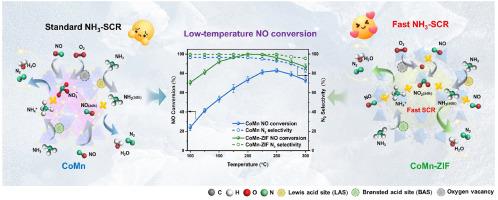ZIF-derived spinel CoMn2O4 with hierarchically porous architecture and optimized surface chemistry for efficient low-temperature fast NH3-SCR
IF 6.2
2区 工程技术
Q2 ENERGY & FUELS
引用次数: 0
Abstract
To address the intrinsic limitations of conventional spinel oxides in low-temperature NH3-SCR, a hierarchically porous spinel CoMn2O4 with optimized surface chemistry was constructed via a ZIF-derived strategy. By leveraging the structural directivity and compositional tunability of the ZIF precursor, CoMn-ZIF displays a sheet-like architecture containing interlinked pores and numerous surface hollows. This effectively mitigates nanoparticle agglomeration, while enhancing gas-phase diffusion and maximizing active site accessibility. Beyond this morphology optimization, this approach simultaneously modulates the key surface chemical properties, characterized by enriched oxygen vacancies, enhanced redox capacity, elevated surface active oxygen species, as well as a high density of Brønsted and Lewis acid sites. Such integrated characteristics enhance NH3 adsorption and NO oxidation, which in turn accelerate the onset and progression of the fast SCR pathway. As a result, CoMn-ZIF shows exceptional low-temperature NH3-SCR performance with above 90 % NO conversion at 150 °C, outperforming conventional spinel CoMn. Moreover, CoMn-ZIF also exhibits remarkable catalytic stability under diverse operating conditions, including fluctuating NO concentrations, varying space velocities, and the presence of H2O and SO2, underscoring its suitability for operation in variable industrial environments. In situ DRIFTS confirms the formation of NO2 and -NH2NO intermediate, providing direct evidence for the dominance of the fast SCR pathway. This study presents a rational strategy for the design of high-performance spinel oxide catalysts targeting efficient low-temperature NH3-SCR applications.

zif衍生尖晶石CoMn2O4具有分层多孔结构和优化的表面化学,用于高效的低温快速NH3-SCR
为了解决传统尖晶石氧化物在低温NH3-SCR中的固有局限性,通过zif衍生策略构建了具有优化表面化学性质的分层多孔尖晶石CoMn2O4。通过利用ZIF前驱体的结构方向性和成分可调性,com -ZIF显示出含有相互连接的孔隙和许多表面凹陷的片状结构。这有效地减轻了纳米颗粒团聚,同时增强气相扩散和最大化活性位点的可达性。除了这种形态优化之外,该方法还可以同时调节关键的表面化学性质,其特征是富集氧空位、增强氧化还原能力、提高表面活性氧以及高密度的Brønsted和Lewis酸位点。这些综合特性增强了NH3吸附和NO氧化,从而加速了快速SCR途径的开始和发展。结果表明,CoMn- zif具有优异的低温NH3-SCR性能,在150°C时NO转化率超过90%,优于传统尖晶石CoMn。此外,在不同的操作条件下,包括波动的NO浓度、变化的空速、H2O和SO2的存在,common - zif也表现出显著的催化稳定性,强调了它在可变工业环境下的适应性。原位漂移证实了NO2和-NH2NO中间体的形成,为快速SCR途径的主导地位提供了直接证据。本研究提出了一种针对高效低温NH3-SCR应用的高性能尖晶石氧化物催化剂的合理设计策略。
本文章由计算机程序翻译,如有差异,请以英文原文为准。
求助全文
约1分钟内获得全文
求助全文
来源期刊

Journal of The Energy Institute
工程技术-能源与燃料
CiteScore
10.60
自引率
5.30%
发文量
166
审稿时长
16 days
期刊介绍:
The Journal of the Energy Institute provides peer reviewed coverage of original high quality research on energy, engineering and technology.The coverage is broad and the main areas of interest include:
Combustion engineering and associated technologies; process heating; power generation; engines and propulsion; emissions and environmental pollution control; clean coal technologies; carbon abatement technologies
Emissions and environmental pollution control; safety and hazards;
Clean coal technologies; carbon abatement technologies, including carbon capture and storage, CCS;
Petroleum engineering and fuel quality, including storage and transport
Alternative energy sources; biomass utilisation and biomass conversion technologies; energy from waste, incineration and recycling
Energy conversion, energy recovery and energy efficiency; space heating, fuel cells, heat pumps and cooling systems
Energy storage
The journal''s coverage reflects changes in energy technology that result from the transition to more efficient energy production and end use together with reduced carbon emission.
 求助内容:
求助内容: 应助结果提醒方式:
应助结果提醒方式:


